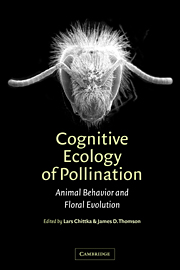Book contents
- Frontmatter
- Contents
- List of contributors
- Preface
- 1 The effect of variation among floral traits on the flower constancy of pollinators
- 2 Behavioral and neural mechanisms of learning and memory as determinants of flower constancy
- 3 Subjective evaluation and choice behavior by nectar-and pollen-collecting bees
- 4 Honeybee vision and floral displays:from detection to close-up recognition
- 5 Floral scent, olfaction, and scent-driven foraging behavior
- 6 Adaptation, constraint, and chance in the evolution of flower color and pollinator color vision
- 7 Foraging and spatial learning in hummingbirds
- 8 Bats as pollinators: foraging energetics and floral adaptations
- 9 Vision and learning in some neglected pollinators: beetles, flies, moths, and butterflies
- 10 Pollinator individuality: when does it matter?
- 11 Effects of predation risk on pollinators and plants
- 12 Pollinator preference, frequency dependence, and floral evolution
- 13 Pollinator-mediated assortative mating: causes and consequences
- 14 Behavioural responses of pollinators to variation in floral display size and their influences on the evolution of floral traits
- 15 The effects of floral design and display on pollinator economics and pollen dispersal
- 16 Pollinator behavior and plant speciation: looking beyond the “ethological isolation” paradigm
- Index
13 - Pollinator-mediated assortative mating: causes and consequences
Published online by Cambridge University Press: 13 August 2009
- Frontmatter
- Contents
- List of contributors
- Preface
- 1 The effect of variation among floral traits on the flower constancy of pollinators
- 2 Behavioral and neural mechanisms of learning and memory as determinants of flower constancy
- 3 Subjective evaluation and choice behavior by nectar-and pollen-collecting bees
- 4 Honeybee vision and floral displays:from detection to close-up recognition
- 5 Floral scent, olfaction, and scent-driven foraging behavior
- 6 Adaptation, constraint, and chance in the evolution of flower color and pollinator color vision
- 7 Foraging and spatial learning in hummingbirds
- 8 Bats as pollinators: foraging energetics and floral adaptations
- 9 Vision and learning in some neglected pollinators: beetles, flies, moths, and butterflies
- 10 Pollinator individuality: when does it matter?
- 11 Effects of predation risk on pollinators and plants
- 12 Pollinator preference, frequency dependence, and floral evolution
- 13 Pollinator-mediated assortative mating: causes and consequences
- 14 Behavioural responses of pollinators to variation in floral display size and their influences on the evolution of floral traits
- 15 The effects of floral design and display on pollinator economics and pollen dispersal
- 16 Pollinator behavior and plant speciation: looking beyond the “ethological isolation” paradigm
- Index
Summary
A typical animal pollinator forages non-randomly among plants in a community, using floral cues to recognize the available options. The tendency of individual foragers to restrict their visits to a subset of the available flowering species increases the proportion of pollen grains that arrive on appropriate stigmas. Pollinators partition themselves among plants in several ways, with the common result of assortative mating according to floral type. First, I discuss the evolutionary implications of assortative mating, in light of recent models that emphasize its importance for species divergence, then review the ways in which pollinator behavior contributes to assortative mating among floral types. Finally, I consider how the different forms of non-random pollinator behavior might influence floral evolution and plant speciation.
There is a long-standing tradition of thought that visitation by different pollinators drives divergence of floral form and provides reproductive isolation among incipient plant species (reviewed by Waser, this volume). However, pollinators rarely specialize completely on a single floral type (plant species or distinct phenotype within a species), leading some investigators to question the role of pollinators in the radiation of the angiosperms, and to suggest that floral evolution is largely decoupled from plant speciation (Waser 1998; Chittka et al. 1999). None the less, the remarkable radiation of angiosperms in parallel with pollinators (Grimaldi 1999), and findings that plant families with animal pollination are more speciose than those with abiotic pollination (Dodd et al. 1999), suggest that animal pollination was a key innovation in flowering plant evolution.
- Type
- Chapter
- Information
- Cognitive Ecology of PollinationAnimal Behaviour and Floral Evolution, pp. 259 - 273Publisher: Cambridge University PressPrint publication year: 2001
- 19
- Cited by

